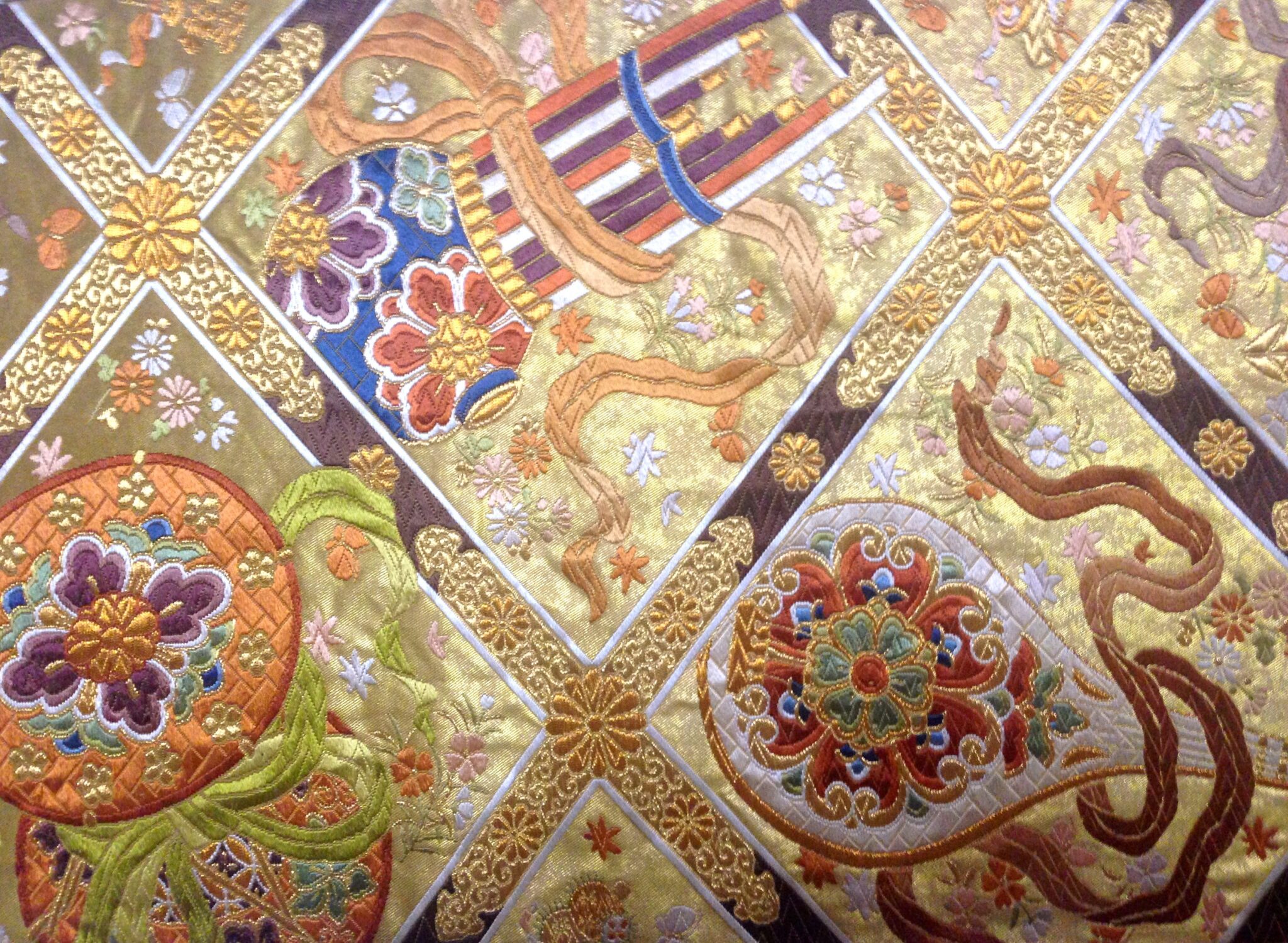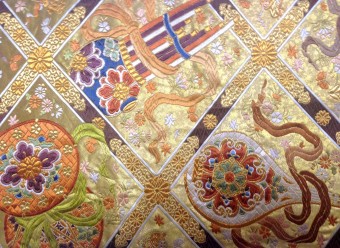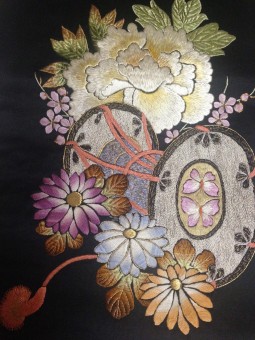Jan 7th, 2015
A Beauty of Japan (1) – 日本の美について英語で語る

皆様、あけましておめでとうございます!
本年もQ-Leapブログを宜しくお願い致します。
2015年、年初いきなりガラにも無く内省スタートです。。。英語の研修やっているんだからブログも英語で書いたらどうなの?という疑問は自分の中にずっと渦巻いていたわけですが、やみくもに何でも英語で書いても読むほうも書くほうも疲れるだけじゃないの?という気持もあり、どうせ英語で書くなら英語で書く意味と価値があるものを書きたいな、と思っていました。そこで自分の英語とのお付き合いの原点に戻りますと、私が外国の方からもっとも求められるのは常に「日本の国、文化、習慣、歴史についての説明」だということに行き当たりました。
その最初の恐怖の洗礼を受けたのが忘れもしないバンコクのインターナショナルスクールで歴史のクラスがいよいよと第二次世界大戦に入った時のことでした。「山本五十六はどんな人?」「天皇の起源は?」「日本はなぜパールハーバー攻撃でアメリカを騙したのか」などなどなど。。。当時高校生だった私は不勉強もありますが、そもそも学校でもそんなこと習ってないし。。。全く答えられませんでした。自分の国の歴史についてしっかり語れない私をクラスメート達が怪訝な表情で見ていたのが今でも忘れられません。
英語が上手く喋れないことよりも自分の国について何も知らないことのほうがよっぽど恥ずかしい
とその時骨身に沁みました。
私が洗礼を受けたような厳しい話題がいきなり親しくもない相手から飛んでくることはあまりないかもしれません、でも平和的な話題なら是非英語で日本のことを話せるようになりたいですよね。というわけで、今年はそこここで Let’s talk about a beauty of Japan in Englishをテーマにしていきたいと考えています。Beauty of Japan, と言ってもあまりにも範囲が広過ぎますので、まずは私にとって身近で、外国の方にももっと知っていただきたいと常に思っていた日本の伝統文様から初めてみようかと思います。お正月ですし、少し華やかなトピックで英語を練習してみませんか。私は着物大好きなので、織物や染め物などに好んで使われる吉祥文様を通して毎回「日本の美」について簡単な英語で話す、書く、練習をしましょうね(というか私がするんですね)!
というわけで今日のお題は
「楽器文 」 Motifs of Musical Instruments
楽器文とは雅楽器をそのまま文様にしたものです。雅楽器をただ traditional musical instrumentと表現した場合、何となくは伝わりますが、一番大事な「雅」の部分が伝わりませんね。雅楽器は musical instruments for Japanese court music です。ちょっと長いですが、court (宮廷)という単語がひとつ入るだけで「雅(みやび)」な感じが伝わりますね。
Background information: 外国の方に日本のことを話す時は具体的な内容を話す前に背景情報をしっかり与えてあげることが大事です。
Court culture of Japan reached its glorious peak in Heian Period, which is about 1200 years ago from now. Heian Period is known as an abundant source of traditional motifs used in various Japanese arts, especially textiles for kimono. Textile art and weaving (織物)were some of the most flourishing (繁栄した) industries back then. Aristocrats (貴族階級)and high-rank politicians enjoyed wearing kimonos decorated with beautiful motifs from nature and things people used everyday. Many of them are called Kisshomon (吉祥文), the motifs of auspicious (幸先の良い、目出たい = lucky) omen. You still can see those Kisshomon motifs everywhere in Japan today.
ここからMain Bodyです。
Today, I would like to introduce one of those auspicious motifs, Gakkimon, motifs of musical instruments for Japanese court music. Japanese court music is seemingly one of the oldest forms of orchestra in the world. Last January, I heard court music at Ise Shrine while we were receiving blessing and purification inside the Shrine’s main building. It was really an inspirational as well as spiritually moving experience.
This picture is an example of Kyoto Nishijin Weaving using motifs of Japanese court musical instruments. You can see various instruments gorgeously woven with colorful silks threads. Real musical instruments are not that colorful, they are rather simple and brownish, but when they are made into motifs, they are usually decorated with vivid colors and flower patterns to emphasize its auspiciousness and gracefulness. As you can see, each instrument is embedded (埋め込まれている) in a square frame of the coffered ceiling (格子天井) individually. Motifs of coffered ceiling are also known as a highly sophisticated geometric pattern (幾何学文様) that represents the ceilings of important architectures of the time: castles, shrines and temples.
On the left bottom corner is Tsuzumi, an elegant hand drum decorated with bright green ribbon. In the middle is Sho, a wind instrument made of bamboo pipes of various lengths. It is like a handy size Japanese style pipe organ or a Scottish bagpipe, which creates an unforgettable sound that often represents Japanese court music. Finally, on the right bottom corner is Biwa, an acoustic guitar brought to Japan in the 8th century via Silk Road. Biwa appears in many of the famous Japanese literatures of this period. In this particular textile, every motif is a symbol of heavenly music played in Buddhism heaven. With its golden back and Kissho motifs, it is obvious that this textile should only be worn for a very formal celebration or auspicious occasions. In such, motifs and quality of the fabric naturally define the class and the use of it, which I think is also a beauty of Japanese traditional textiles. When you wear a kimono, you need to know what is appropriate to wear in what kind of occasions and seasons.
This is actually one of my Obi sashes I used to wear when I was younger. Now this pattern is too young for me, so this is going to be my daughter’s very soon. She may wear this with her Kimono for ‘Coming-of-Age-Day (成人式)’ celebration in two years time.
Here is another Obi sash with a similar motif, but this one is not for formal occasions. You cannot see it from the picture, but this Obi is tailored in Nagoya style and it is not woven, which makes this Obi basically for semi-formal to casual use. This one is hand-embroidered by my grandmother when she was young. She told me that she had been taking Japanese hand-embroidery classes for many years and this was one of her practice works. I love this Obi but it is a little too short for me as my grandmother was a very little lady. However, every time I see this Obi, it reminds me of her gentle smile and many of her needle works.
Here you can also see a Gakkimon, a motif of Tuzumi, a hand drum, decorated with beautiful auspicious flowers: a peoney (牡丹), chrysanthemums (菊) and Japanese ume (apricot) flowers. This Obi is nearly 90 years old, but it is still in an excellent condition. Since my daughter is much smaller than I am, this Obi should suit her quite well.
In my personal view, Gakkimon, motifs of musical instruments, are very feminine and that is why these are often accompanied with flower motifs. I could not introduce all the court musical instruments in this blog, but there are also a famous Koto, a Japanese string instrument and Yokobue, a Japanese flute.
Next time you see Gakkimon somewhere, please check them out!
と長々書いてみましたが。疲れたので次回はもっと簡単なものにしようと思います。間違いもいろいろありそうですが、そういうものを皆さんの前にさらしていかないと自分の向上も無いかな、と思っていますのでいろいろご指摘くださると嬉しいです。
英語で日本特有のものについて書いたり話したりするのは自分にとってもとても良い練習になります。
好きなことだと知っていることが多くてあれもこれも書きたくなりますが、簡潔に、簡単な英語で説明できるといいですよね!
皆さんも間違いを気にせずにばんばん練習して下さいね。
慶應義塾大学卒
コロンビア大学ティーチャーズカレッジ英語教授法(TESOL) 修士号取得
米穀物メジャーCargill, 石油メジャーBPの外資2社に計10年トレーダーとして勤務。その間ChicagoとNYに3年駐在。
現在企業のエクゼクティブ担当として数多くのプライベートレッスンを手がけている。
その他大学、専門学校でTOEIC SW クラス、TOEIC公開講座などを担当中。
2014年 ビジネス英語研修会社 Q-Leap 設立

